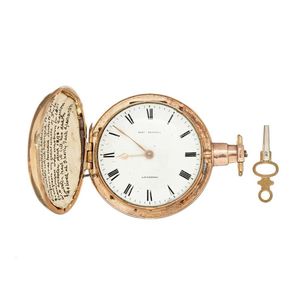Georgian Gold Pocket Watch by Robert Roskell, Liverpool
You must be a subscriber, and be logged in to view price and dealer details.
Subscribe Now to view actual auction price for this item
When you subscribe, you have the option of setting the currency in which to display prices to $Au, $US, $NZ or Stg.
- Georgian - As an English stylistic period, Georgian is usually taken to cover the period from George I (1714) to the Regency of Prince George (1811-20), although the period from 1800 to 1830 is sometimes designated as the Regency period. During the Georgian period the great English cabinetmakers and designers such as Chippendale, Hepplewhite, Adam Sheraton etc., were all active.
Therefore there isn't a single 'Georgian style' as such and to say something is 'Georgian', usually means it was made between 1714 and 1830. This assumes we discount George V and George VI, both being from the 20th century.
The styles popular at the time of each reign were:
George I (1714-1727) saw out the last years of the Baroque period.
George II (1727-1760) reigned during the Rococo period.
George III (1760-1820) saw the last gasp of the Rococo, all of the early Neo-Classic 'Adam style' and most of the later neo-Classic 'Regency style'.
George IV (Prince Regent 1820-1830)encompassed the last of the 'Regency' style.
William IV's reign (1830-1837) was something of a no man's land (stylistically) and he wasn't a 'George' anyway. He covered the last glimmerings of 'Regency' and the start of the 'Victorian' style. - Movement - The technical name for the workings of a clock or watch, and does not include the dial or case.
- Fusee - The fusee movement was used in clocks and pocket watches from the mid 17th century. The fusee is a cone shaped drum within the works that is linked to the barrel of the spring, usually by a length of chain.
As the mainspring loses its tension over time, the cone shaped barrel compensates for this by increasing the tension, by pulling the mainspring tighter, thus ensuring the time remains constant.
Use of the fusee in clocks was superseded by the "going barrel" in the mid 19th century and for pocket watches at the beginning of the 19th century.
The fusee continued to be used in marine chronometers until the 1970s. - Date Aperture - A date aperture is a cut out section in the face of a watch or clock, displaying the day of the month.
- Hunt & Roskell - Hunt & Roskell, were a firm of manufacturing and retail jewellers and silversmiths, founded in 1843 by Robert Roskell a famous pocket watch maker from Liverpool, and John Samuel Hunt who had previously been in partnership with silversmith Paul Storr, trading Storr & Co. (1819-22), Storr & Mortimer (1822-38), Mortimer & Hunt (1838-43) and then Hunt & Roskell (1843-97).
Hunt & Roskell had retail premises at 156 New Bond Street and a manufacturing workshops at 26 Harrison Street, near Clerkenwell.
They were among the finest of the Victorian silversmith, manufacturing in the high Victorian style, and their craftsmanship was recognised by their appointment as silversmiths and jewellers to Queen Victoria.
John Samuel Hunt continued as a partner until his death in 1865, when he was succeeded by his son, John Hunt (d.1879). Robert Roskell remained in the firm until his death in 1888. In 1889 the firm was taken over by J.W. Benson and continued in business as Hunt & Roskell Ltd until c.1965.
This item has been included into following indexes:
Visually similar items

A good hunter cased gold Victorian 'Dent' pocket watch, the covers engine turned & Hallmarked London 1879 (presentation inscription) signed 'Royal Exchange maker to the Queen', N.40092. Fusee and chain lever movement with bi-metallic balance. Enamel dial i

Pocket watch: gentleman's 9ct gold crown wind hunter pocket watch. 48 mm.

A Swiss 'Perret & Fils'. 14ct gold hunter pocket watch, 13 jewel lever movement spiral Breguet hair spring N.35138 bi-metallic balance. Rolled gold bow. Stamped 56. Enamel dial with faint hairlines. Diameter 50 mm. Weight 96gms.

An American Howard, 14ct gold hunter pocket watch, in a plain case with engraved initials. Enamel dial in good order. Covers marked. Keystone 14ct. 17 jewel lever movement with micrometer adjustment to balance, signed E Howard watch Co. Boston. Diameter 50
